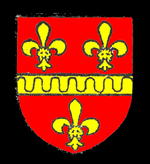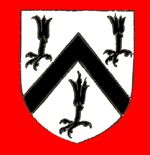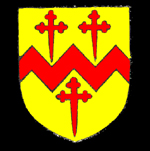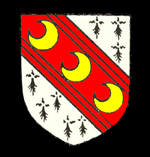The Victoria County History for Bedfordshire, published in 1910, lists three manors in Totternhoe, confusingly all called Totternhoe Manor. The first of these was based on the holding of William of Flanders in 1086. He was later known as William de Wahull and Totternhoe formed part of the Barony of Wahull, or Odell until 1284 when feudal assessors declared that they could not find who was entitled to the overlordship and it reverted to the Crown.

Cantlowe family coat of arms
The tenant in 1086 was one Osbert. The next known tenant is Roger de Welton who held the manor at the beginning of the 13th century. William, Roger's son, held the manor in 1257 and was succeeded by his son, another Roger. By 1276 the manor was in the hands of the Cantlowe family, specifically Millicent de Montalt, sister and co-heir of George Cantlowe who had died in 1273.

Welton family coat of arms
On Millicent's death in 1298 the manor passed to her son by Eudo la Zouche, William. He settled the manor on his second son William, but he released his interest in 1333 and his father settled the manor on another William, the son of his eldest son Eudo and thus the elder William's grandson. In 1352 he was summoned to parliament as Lord Zouche of Harringworth. On his death in 1382 the manor passed to his son William., who was banished from the court of Richard II as one of his "evil councillors" in 1389. A string of William Zouches held the manor until 1468 when a minor, John Zouche, inherited the manor and his mother, who had married Gilbert Debenham after her husband William Zouche's death, held the manor until her death in 1470. John Zouche fought for Richard III at Bosworth Field in 1485 and was attainted fro treason by the usurping Henry VII and his lands confiscated.

Bray family coat of arms
In 1490 Totternhoe manor was granted by the King to Reginald Bray (from whose family Eaton Bray took its name). John Zouche's attainder was reversed in 1492 but Bray kept his Bedfordshire lands by paying Zouche 1,010 marks (£673/6/8). Reginald Bray became High Treasurer and Treasurer of the Duchy of Lancaster. He was also an architect and designed Saint George's Chapel, Windsor and Henry VII's Chapel in Westminster Abbey. He died without issue in 1509 and was succeeded by Edmund, son of his brother John.

Sandys coat of arms
John was created Lord Bray and left the manor to his son John on his death in 1539. He died without his issue in 1557 and was succeeded by his brother Edward who died the following year and was succeeded by his son Edward. He sold the manor in 1566 for £1,333/6/8 to Edmund Bray who then sold it in 1574 to Walter Sandys.

Huxley family coat of arms
The manor then remained in the Sandys family until 1623 when it was sold to John Huxley. The manor then remained in that family until 1742 when Thomas Huxley left it in his will to his brother-in-law Isaac Hughes in trust to sell it to raise legacies for his daughters. The manor was purchased by John Potter, Archbishop of Canterbury who left it to his son Thomas. He left it to his son, another Thomas, who sold it to William Beckford, Lord Mayor of London in 1763. His son William held it by 1781.
In 1811 the Manor was sold by auction in London [BW998] and the buyer was, it is presumed, a man named Basterfield who is shown as the owner of Manor Farm in 1829. The manor seems to have been bought some time after 1840 by Earl Brownlow. A succession of Law of Property Acts in the 1920s extinguished all manorial incidents, courts and copyhold tenure of land. This effectively abolished manors in all but name.
The second Totternhoe Manor is likely to have had its genesis in the land held by William the Chamberlain in 1086. The first mention of it, however, is in the early 13th century when William de Landas held a messuage (building) and carucate of land. In 1234 his son Nicholas released it to William de Eltesden. His son John first mortgaged, then sold his lands in Totternhoe to Thomas Inge. In 1302 Ing'e son William died leaving the manor to his daughter Joan, wife of Eudo la Zouche. Their son William inherited this manor and also the larger Manor of Totternhoe from his grandfather and the two manors seem to have become amalgamated.
In 1518 another Totternhoe Manor was described as the property of Ralph Watford. William Watford had held lands in Totternhoe in 1346 and the same property had been owned by a Giles Watford in 1428. It is possible that this holding had some connection with the five hides held by unnamed men in 1086 or with two hides taken from William the Chamberlain by Odo, Bishop of Bayeux but there is no evidence for this. Ralph Watford sold the manor in 1518 to Thomas Pygott, a lawyer and it passed to his son William in 1521, In 1595 William's grandson Francis sold it to Richard Moorewho sold it to Oliver Style in 1614. By 1619 it was held by John Buckmaster who sold in to Samuel Dagnoll in 1623 and he sold it to Ambrose Aldridge in 1630. In 1631 it was in the hands of George Barber alias Grigge. By the beginning of the 18th century the manor was held by London grocer John Mead, William Mead's daughter married John Wilkes, a London alderman who held the manor in 1782. His daughter inherited it but died in 1802. Some time before 1813 the manor was acquired by Earl Brownlow whose family held it into the 20th century. The Totternhoe Estate was put up for sale in 1916 and manors themselves were effectively abolished by the Law of Property Acts in the 1920s.
Manor Farm at Lower End may be on or near the site of one of the last of these manors. Bedfordshire Historic Environment Record [HER 530] notes that the farm is supposed to be the site of a moat recorded as still in good condition in 1951 but disappeared by 1966, apparently filled in. Archaeological trenching in 1993 found no remains of the moat and it is therefore presumed to have been completely destroyed. The moat is shown on a map of 1829, and a sale catalogue in 1811 calls the site Manor Farm, and mentions its moat. The site of another manor may well have been in the vicinity of 299-301 Castle Hill Road (once part of Manor Farm) as a moat, often indicative of the site of a manor house, lay nearby, as noted in the sale particulars of 1916.